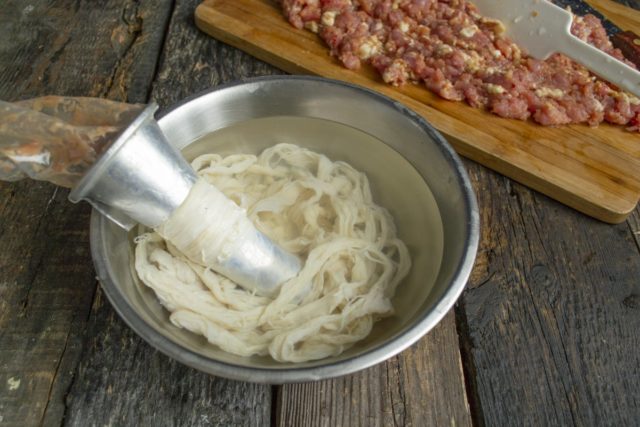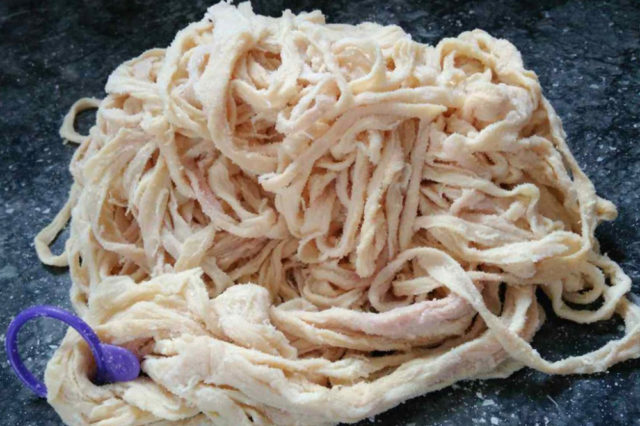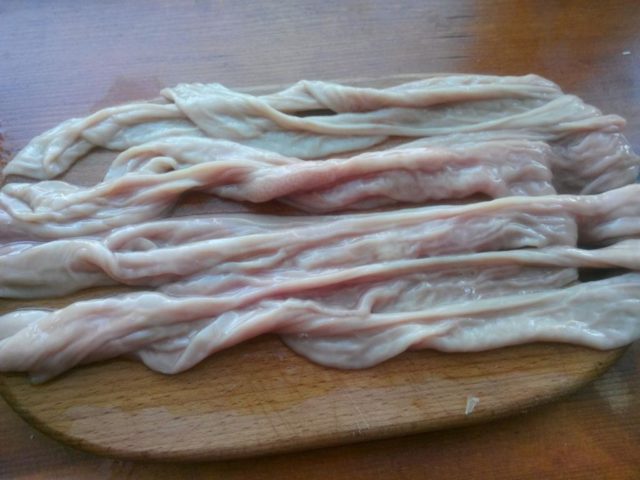Content
Peeling pork intestines for sausage is not difficult. Fans of such products know that the most delicious and healthy product is obtained when cooked at home in a natural casing. It can be found cleaned in the store or processed and prepared for future use yourself.
How to prepare pork intestines for homemade sausage
For the preparation of sausages at home, many housewives prefer to use pork intestines. They are versatile, as they are suitable for various types of meat, mixtures of them, as well as vegetables, cereals and other ingredients. With them, grilled sausages, hunting sausages, uncooked smoked, hot smoked products are prepared.

One of the advantages of pork giblets is that even housewives who do not have special knowledge and skills can process them.
Preparing pork intestines for sausage is a simple process. It requires:
- protective gloves for hands so that the skin does not absorb the characteristic, persistent odor;
- thick oilcloth or film for the table;
- individual cutting boards (after work, they should be washed with soda and sprinkled with vinegar).
The preparation of casings is carried out after cutting the carcass so that they do not lose strength and elasticity. Intestines from one animal allow you to process and hold up to 15 kg of minced meat.
How to Process Pork Intestines for Sausage in the Traditional Way
Housewives and chefs know several ways to clean pork intestines. One of them is considered traditional and is as follows:
- The casings are washed in cold water.
- Cut into several pieces, the length of which can be from 2 to 5 m.
- Since touching the intestinal epithelium can be unpleasant, it is best to squeeze it out before cleaning the intestines of the pigs under running water.
- Each piece is turned inside out. To make it easier, take a crochet hook or knitting needle, any pointed sticks. They cling to the edge of the shell and thread it inside, stretching along the entire length.
- Take utensils for soaking the product. Fill it with water, add salt and soda at the rate of 2 tbsp. l. for 1 liter of liquid.
- Placed in a giblet solution, leave for 5 hours. This is necessary to remove fat and destroy harmful microorganisms.
- Cleanse the product from the epithelium with a knife.
- Soak again in cold water for 2 hours.
- Rinse. If necessary, you can peel and rinse the sausage casings again. They must become transparent.
- After they are pulled onto a tap and washed. At the same time, the integrity of the shell is checked.
- Turned out.
How to clean pork intestines for sausage: a quick method
The traditional way to wash offal is time consuming. You can quickly clean the pork intestines for the sausage. They do it like this:
- Squeeze out the epithelium with your hands to clean the inside.
- The intestines are inverted using any suitable device, such as a knitting needle.
- Washed out.
- Heat the water. If the small intestines are taken, then the water temperature is brought to +50 degrees. If thick, then up to +90. Leave them in liquid for 4 hours.
- Then it remains to clean the epithelium with a knife, rinse under running water.
- At the end, rinse in a solution of potassium permanganate (potassium permanganate) to eliminate the unpleasant odor and disinfect.

A quick way to clean offal is appropriate if it belonged to a young animal.
How to treat pork intestines to get rid of odor
If the hostess decides to clean the pork intestines at home, she is faced with the problem of an unpleasant odor, which can be difficult to get rid of. This is one of the difficulties of self-cooking sausages, especially if such work has to be done by a beginner. The product can absorb the "flavor" and become inedible.
Thoroughly washing pork intestines for sausage and peeling is not enough. It is necessary to apply other methods:
- Soaking in a soda solution. To dissolve it, take 2 tbsp. l. powder per 1 liter of water. Leave the product in the liquid for 5 hours. This helps to get rid of the microorganisms that cause the odor.
- Treatment in potassium permanganate solution. Like soda, potassium permanganate kills microbes and disinfects.
- Immersion in potato mass. Raw peeled root vegetable is grated. Pork intestines are lowered into the resulting mass and left for 2 hours. Then rinse.
Storage methods for cleaned pork intestines
Housewives who have cooked pork intestines at least once on their own know that they always remain in surplus. The product has to be processed for long-term storage. This is done in various ways. The most common way:
- properly clean pork intestines for sausage,
- wash them;
- after disinfection in a solution of soda or potassium permanganate, rub with salt;
- Pour the product prepared for future use with it, folded into any container.

This harvesting method is suitable for those cases where the casing needs to be stored for no more than a year.
In order for the product to be usable for up to 5 years, it must be folded into a glass container, filled with saturated salt solution and rolled up.
Another storage method is called dry storage, as it involves drying the intestines of the pigs. They must be pre-processed:
- clean and rinse;
- treat with a disinfectant;
- soak in saturated saline solution;
- hang to dry on a rope.
The dried shells become transparent and rustle when touched. Before making sausages, they must be immersed in water for several hours.
Surplus can also be stored using the cold method, that is, by freezing. To use it, you must:
- clean, rinse and disinfect pork intestines;
- soak them in a saturated salt solution;
- divide into several portions and send to the freezer.
How to make canned pork casings for sausage
The main work on the preparation of purchased, canned pork giblets for homemade sausages is to peel them from the outside and from the inside, and rinse them thoroughly. The workpiece must be divided into pieces of the desired size, turned out, soaked for several hours and rinsed again. After that, the giblets are ready to be filled with minced pork.
In shops and markets, you can buy frozen, dry, canned in brine pork intestines. There are differences in their preparation.
Frozen
If the tripe was prepared for future use by freezing, it can be put in a deep dish and left to thaw in a warm room, or immersed in water.Then make a saline solution and soak for 2-3 hours.
Dry
If dry pork intestines are used for homemade sausages, then their preparation goes through the following stages:
- The casing is inspected to check for cracks or holes. If it is damaged, then the area with the defect is cut off.
- Dry giblets are soaked in cool water. Processing time is about half an hour.
- Prepare a solution with table vinegar, 1 tbsp. l. for 1 liter of water. Pork intestines are dipped into it so that they become pliable, soft.
Canned in brine
The casings for homemade sausage, preserved in brine, acquire a special, piquant taste. It is recommended to prepare them for filling with minced meat in the following way:
- Peel off salt, rinse under running water.
- Cut into pieces of the required length and check for defects.
- Heat the water to a temperature of 30 degrees, soak the entrails in it. This helps to remove excess salt and soften the shell.
- Marinate in brine for 1-2 hours.

If all canned giblets have not been used in the preparation of sausages, they can be squeezed out, covered with salt and sent to the refrigerator.
Professional advice
People who have a lot of experience in making sausages in natural casing share an alternative way to quickly peel pork offal. If they need to be prepared in large quantities, then scraping everything with a knife is long and difficult. You can use this trick:
- Take a deep basin or any other large volume container. Put pork intestines in it.
- Top with salt and flour.
- Add citric acid.
- Giblets rub and wrinkle as if washing clothes.
- Turn inside out and repeat this procedure.
- Wash well in running water.
Professionals use small-diameter pipes or other objects in the form of a cylinder to clean the offal. Pork intestines are pulled over them. This is done to make it easier to clean the sausage casings. They are washed with a dish sponge or a washcloth mitten.
Conclusion
Even a beginner in the culinary business can clean pork intestines for sausages - for this you need to know the basic rules. For 1 kg of meat, professionals advise taking a piece of about 2 m. Before processing, the giblets are matte, painted in a pinkish tint. When they are ready to be filled with minced meat, they turn transparent and white. The main task during cleaning is to scrape them out as best as possible from the inside and outside and rinse thoroughly.








